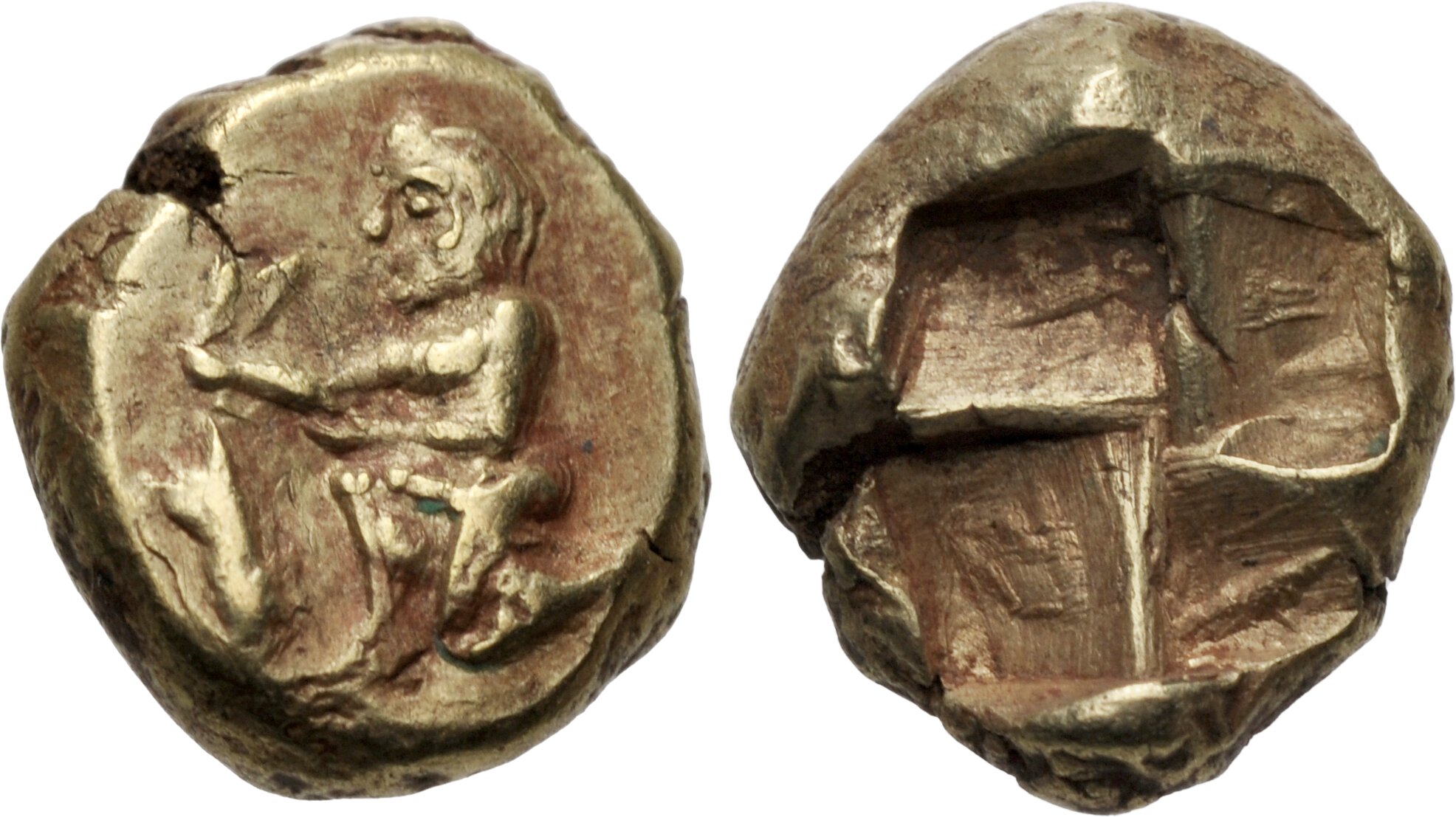S 1761 - Cyzicus, electrum, 12th staters (420-333 BCE)
From SILVER
420 BCE - 333 BCE Electrum 18,429 kg
Description
| ObverseInscription or printing placed on the obverse.: | Satyr kneeling left, holding in his extended right hand a tunny fish by the tail |
| ReverseInscription or printing placed on the reverse.: | Quadripartite incuse square |
Mint and issuing power
| MintIdentifies the place of manufacture or issue of a numismatic object.: | Cyzicus | Ancient regionAncient region.: | Mysia | Modern countryModern country: Turkey | AuthorityIdentifies the issuing power. The authority can be "pretended" when the name or the portrait of X is on the coin but he/she was not the issuing power. It can also be "uncertain" when there is no mention of X on the coin but he/she was the issuing power according to the historical sources: | Persian Empire |
Chronology
| FromIdentifies the initial date in a range assigned in a numismatic context. | 420 BCE | toIdentifies the final date in a range assigned in a numismatic context.. | 333 BCE | PeriodTime period of the numismatic object.: Classical 480-323 BC |
Physical description
| MetalThe physical material (usually metal) from which an object is made.: | Electrum http://nomisma.org/id/el | Median weightMedian of the weights of numismatic objects (in grams). in grams | 1.30 | DenominationTerm indicating the value of a numismatic object. Examples: tetradrachm, chalkous, denarius.: | 12th stater | StandardStandard.: |
Image

S1761 Cyzicus 12th staters.jpg [1]
References
| Die study referencePublication of the study: | Callataÿ 2020a1Callataÿ 2020a, p. 660 | ||
| Coin series referenceReference to coin series study: | Sear II2Sear II, n° 3836-3837 | ||
Obverse dies distribution
no distribution is available
Reverse dies distribution
no distribution is available
Quantification
| Number of obversesNumber of obverse dies. ᵖ (o) | 37 | Number of singletons (o1)The number of singleton coins. ᵖ | |
| Number of reverse diesNumber of reverse dies. (r) | Number of coinsNumber of coins. (n) | 64 | |
| Coins per obverse dieNumber of coins per obverse die. (n/o) | 1.73 | Coins per reverse dieNumber of coins per reverse die. (n/r) | |
| Reverse per obverse ratioRatio of obverse dies divided by reverse dies. (r/o) | Percentage of singletons (o1)number of coins (n) divided by the number of singletons (o1) ᵖ | % | |
| Original number of dies (O) (Carter 1983 formula)The estimation of the number of coins according to Carter 1983 ᵖ | 70.88 | Coins struck if 20,000 as average productivity per dieCoins made if the average productivity for obverses (according to Carter) is 20,000. ᵖ | 1,417,600 |
| Original number of dies (O) (Esty 2011 formula)The estimation of the number of coins according to the singleton formula in Esty 2011 ᵖ (O) | 87.7 | Survival rate if 20,000 as average productivity per dieSurvival rate if average productivity is 20,000. ᵖ | 0.00005 |
| Coverage (o = % of O) (Esty 1984 formula)Esty 1984 - coverage (% of O) ᵖ (o = % of O) | % | Die productivity if survival rate 1/2,000Average productivity if survival rate is 1/2,000. ᵖ | 1,805.87 |
| Weight of silver (in kg) if 20,000 coins per die (O = Carter formula)Carter 1983 * Median weight * 20000 (*10 if gold or electrum) ᵖ | 18,429 kg <br /> 18,429 kg | Die productivity if survival rate 1/5,000Average productivity if survival rate is 1/5,000. ᵖ | 4,514.67 |
Remarks
This is a very rough estimate produced on a sample of 1,810 coins (for all denominations)
References
- ^ Callataÿ, François de (2020), “Prolegomena to a die-study of the electrum coinage of Cyzicus,” in Peter van Alfen and Ute Wartenberg (eds.), White Gold. Studies in Early Electrum Coinage, New-York-Jerusalem, The American Numismatic Society & The Israel Museum, p. 641-664.
- ^ Sear, David R. (1979), Greek coins and their values. Vol. II, Asia and North Africa, London, xlviii, p. 317-762